 |
 |
| Home | Welcome | What's New | Site Map | Glossary | Weather Doctor Amazon Store | Book Store | Accolades | Email Us |
 | |||||||||||||||||||||||||||||
Weather Almanac for December 2010SKYING WITH JOHN CONSTABLE
Eric Sloane asserted he had coined the term skyscape to describe his style of sky/cloud paintings. But a century earlier, Constable gave sky/cloud paintings a name when he coined the term skying to describe his artistic focus on clouds. His obsession with clouds was such that from 1820 to 1821 he focused a series of paintings and sketches — numbering around 50 — looking upward from the English landscape that combined the naturalist’s eye with the artist’s. And like Sloane, who studied meteorology at MIT for a time to better understand the sky, Constable studied the writings Thomas Forster’s Researches About Atmospheric Phaenomena, a popularization and extension of Luke Howard’s 1804 essay Modification of Clouds. The annotations in his copy of Thomas Forster’s book indicate he kept abreast of the state of the science, at times even arguing with Forster’s interpretation. The LifeJohn Constable was born on 11 June 1776 in the village of East Bergholt, Suffolk, England, the son of Golding Constable, a wealthy grain merchant, miller and small ship owner. Though his parents expected him to succeed his father in the family business, which he did for a time, young John preferred rambling the Suffolk countryside and sketching the land that was to become the subject of much of his art. These rambles “made me a painter and I am grateful” … “the sound of water escaping from mill dams etc., willows, old rotten planks, slimy posts, and brickwork, I love such things.” While visiting relations in Middlesex, Constable met John Thomas Smith, a professional painter who spoke with him about painting and gave Constable advice on his career path. Smith suggested he paint part-time as an amateur and run the family business as his main source of income. In 1799, however, Constable persuaded his father to allow him to pursue art as a career. With a small allowance, John entered the Royal Academy Schools. In 1802, he turned down a good position as drawing master at the Great Marlow Military College, determined to become a professional landscape painter. He wrote: “For the last two years I have been running after pictures, and seeking the truth at second hand. I have not endeavoured to represent nature with the same elevation of mind with which I set out, but have rather tried to make my performances look like the work of other men…There is room enough for a natural painter. The great vice of the present day is bravura, an attempt to do something beyond the truth.” By 1803, Constable was exhibiting paintings at the Royal Academy, but he was forced to undertake portrait painting (which he found dull work), and a few uninspiring religious works, to make ends meet. He divided his year, spending winters in London and studio work and summers in East Bergholt producing landscapes in his favorite setting. It took until 1819 before Constable began selling his larger canvases — “six footers” as he called them — including his first major work The White Horse. He was elected an Associate of the Royal Academy the same year. 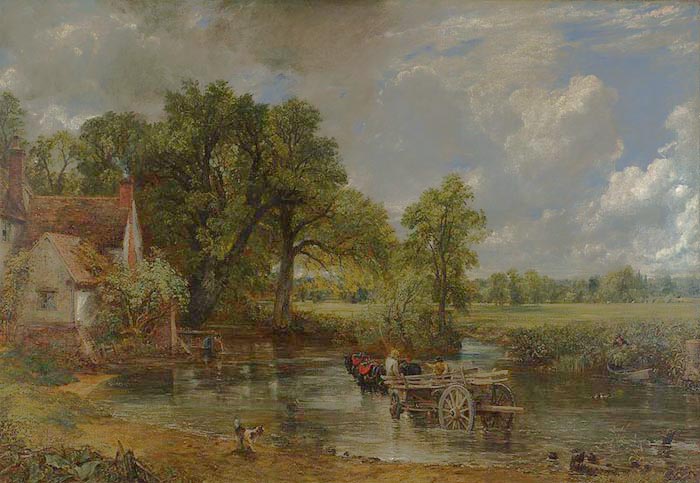 The Hay Wain (1821) by John ConstableTwo years later in 1821, he produced perhaps his most famous painting The Hay Wain, which won a gold medal at the Paris Salon exhibit of English paintings in 1824. It was said that the famed French artist Eugène Delacroix was so overwhelmed by the bright colors in these works that he took down his painting Massacre at Chios and returned to his studio to rework its sky. In France, Constable’s success was immediate, and his revolutionary style had great influence on a number of the younger landscape painters. Unfortunately, Constable was never a commercial success in his homeland during his lifetime, selling more paintings in France per year than England in total (20), but he steadfastly refused to travel abroad to promote his works. With the death of his beloved wife in 1828, he undertook the raising of their seven children alone. At age 52, Constable was finally elected to the Royal Academy in 1829. Two year later, he was appointed Visitor at the Royal Academy. He was a popular lecturer and undertook a series of public lectures on the history of landscape painting. Constable died on 31 March 1837. His Art StyleConstable stood at odds with the prevailing art style of his time, which favored works composed from the imagination. He felt his paintings should portray nature as it unfolded before him. He wrote: “The world is wide; no two days are alike, nor even two hours; neither were there ever two leaves of a tree alike since the creation of all the world; and the genuine productions of art, like those of nature, are all distinct from each other.” Although he would produce larger works from his preliminary sketches, many consider the sketches with their vigor and expressiveness as his best works. In addition to oil painting, Constable was a master at watercolors. Many critics consider his 1835 work Stonehenge featuring a double rainbow accompanying the great monolith as one of the greatest watercolor works of all time. 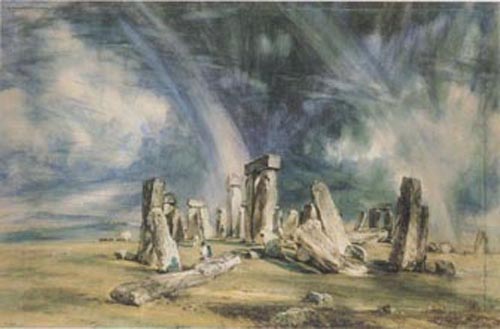 Stonehenge (1835) by John ConstableConstable and his illustrious contemporary J.M.W. Turner would revolutionize painting with their bold styles and passion for the atmospheric. His full-scale plein airsketches (works done in the open air) are the first such ever done with oils. Their bold color, vigorous brush strokes, and attention to atmospheric detail demonstrated that landscape painting could move in a totally new direction. Constable used broken brushstrokes to portray the effects of movement and light in the scene. His deft use of thinned oils on paper gave the impression of watercolors. Constable often placed the horizon line low on the canvas, opening more space for his skies. Constable gradually evolved his techniques in search of a perfect rendering of the more transient atmospheric effects. The process by which Constable painted has been described by Redgrave. He generally worked the whole canvas, building up every part of his subject, initially laying in all the masses in color with a palette knife. By laying in the paint with the palette knife, he obtained great broadness and flatness of touch and the full purity of his pigments. Then, he would build up the scene with glazes, and finally work up the details so that he could best capture the fleeting details of light and shadow. Rather than portray skies as a stylized, flat, uniform background, he tried to capture the changing light and patterns of the clouds across the sky as they occurred; therefore, most studies were completed within an hour. One powerful example, and a true weather scene, is his 1824 sketch Seascape Study with Rain Cloud, painted at Brighton that depicts a convective downpour at sea. 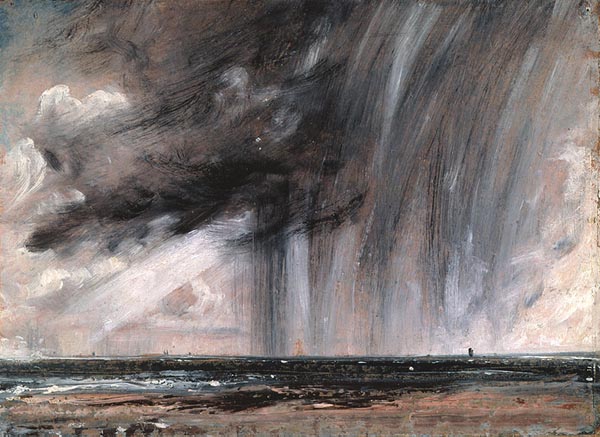 Seascape Study with Rain Cloud (1824) by John ConstableMany see Constable’s use of intense color and color to create tonal value as a forerunner to the Impressionists. He abandoned the classical browns in landscapes and became determined to use color in a realistic manner. To him, the most characteristic feature of his home region was the greenness of the fields and forest. Most of his works were painted in the summer, often near the noon hour, when the foliage was at its brightest verdure. However, he considered summer mornings the best time for painting: ‘Nature is never seen, in this climate at least, to greater perfection than at about nine o’clock in the mornings of July and August, when the sun has gained sufficient strength to give splendour to the landscape, :still gemmed with the morning dew”’, without its oppressive heat; and it is still more delightful if vegetation has been refreshed with a shower during the night” 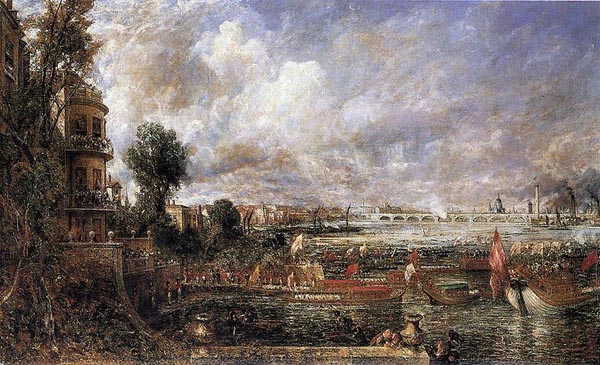 The Opening of Waterloo Bridge (1829) by John ConstableConstable refused to paint his skies as “white sheets drawn behind the Objects” but rather as “a very material part of [the] composition.” Thus, the skies in Constable’s paintings were not just background filler to the subject but a dominant component of the work. As a result, the weather in his paintings often is what first attracts the viewer. Swiss artist Henry Fuseli sarcastically critiqued Constable’s landscapes saying “I like the landscapes of Constable; he is always picturesque, of a fine colour, and the lights always in the right places; but he makes me call for my great coat and umbrella.” In 1853, the editor of Bryan’s Dictionary of Artists spoke of Constable’s style as follows: “His mode of painting was peculiar; he neither imitated the ancient masters, nor the modern; whether he really copied nature, time will discover. The singularity in his pictures makes them striking. His skies are clouded, and his clouds turbulent; they are charged with thunder, lightning, and rain; and when the shower falls, instead of verdant freshness, his trees and meadows are covered with fleeces of snow. These appearances his admirers consider the proofs of strict attention to nature; that they truly exhibit her gloomy grandeur; and that the scattered lights are sparkling touches of genius distributed with a masterly hand.” The “fleeces of snow” referred to above was actually Constable’s habit of using points and spots of pure white to show the sparkle of white light on foliage, when reflecting raindrops lay on the many surfaces. Unfortunately, contemporary critics misunderstood these highlights, calling them meaningless and nicknaming them “Constable’s snow.” In an article written about Constable in 1909 (author unknown) it was said: “The bursting of the rain-cloud, the sunlight struggling through masses of piled-up cumulus, the rush of the wind through the bending tree-tops, the arc of the rainbow stretched across the leaden path of the departing thunder-storm, or the sparkle of grass and foliage after a summer shower, these were the effects which he best loved to paint, effects which he had so constantly studied that he could render them with a vivid realism.” In addition to the full-scale oil sketches, Constable produced many observational studies of landscapes and clouds, determined to more scientifically record the atmospheric conditions. Constable viewed these studies as working-tools, and rarely parted with them. He had no objection, he remarked, “to part with the corn, but he would not let go the field which grew it.” 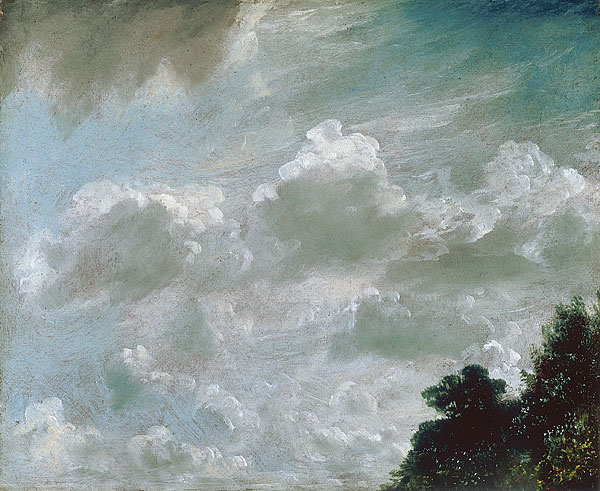 Cloud Study Hampstead, trees at right (1821) by John ConstableConstable believed the sky was “the key note, the standard of scale, and the chief organ of sentiment” in a landscape. Thus, he would note the weather conditions, direction of the light, and time of day on the back of many sketches, sometimes in great detail. One example is his Cloud Study Hampstead, trees at right from 11 September 1821, which has the following inscription on its back: “'Hampstead, Sepr 11, 1821. 10 to 11. Morning under the sun — Clouds silvery grey, on warm ground Sultry. Light wind to the S.W. fine all day — but rain in the night.” Interestingly, in this note, he not only described conditions while painting, but added the weather events following the session: “rain in the night.” This may indicate the desire of Constable to understand the weather sequence unfolding, similar to the frontal-cloud models of the twentieth century. Constable wrote to Rev. John Fisher on 23 October 1821:” I have done a good deal of skying– I am determined to conquer all difficulties and that most arduous one among the rest, & now talking of skies …That Landscape painter who does not make his skies a very material part of his composition – neglects to avail himself of one of his greatest aids.” Two years later, Constable commented to Fisher: “You can never be nubilous — I am the man of clouds.” While Constable was accurate in depicting cloud scenes, he took some artistic license with rainbows. John Thornes has studied Constable’s works for twenty years and believes Constable to be the most accurate painter of skies. However, according to Thornes, Constable took liberties with rainbows, adding them when he wanted. At times he showed rainbows high in the sky at noon, a situation which cannot occur during the English summer. In the painting Salisbury Cathedral From The Meadows (1831), the shadows tell us the piece was painted in the late afternoon or early evening, and therefore the rainbow arching over the cathedral is too high for the time of day and at the wrong angle relative to the sun. 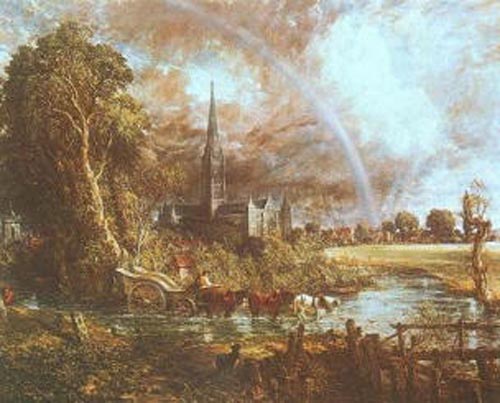 Salisbury Cathedral From The Meadows (1831) by John ConstableIn his public lecture series on landscape painting in 1836, Constable noted that landscape painters should be “scientific as well as poetic; that imagination never did, and never can, produce works that are to stand by a comparison with realities.” He had planned lectures on the science of painting skies and meteorology. He wrote in December 1836: “My observations on clouds and skies are on scraps and bits of paper and I have never yet put them together so as to form a lecture, which I shall do, and probably deliver at Hampstead next summer.” Unfortunately for us, Constable never delivered this companion lecture “The Science of Painting the Sky,” for he died the following spring. And no manuscript or notes have survived, if they were ever written. Constable’s style had influences that reached far beyond the local scene in both space and time. He influenced contemporary painters Théodore Géricault and Delacroix and the Barbizon school — a group of French painters, that included Millet and Corot, who abandoned formalism and drew their inspiration from nature — as well as the French impressionists of the later nineteenth century. The following small gallery shows several more of my favorite Constable works.
Written by
|
|||||||||||||||||||||||||||||
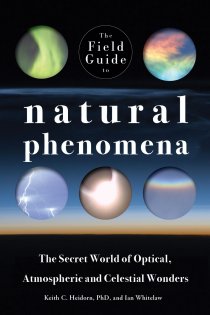 |
Now AvailableThe Field Guide to Natural Phenomena: |
 |
To Purchase Notecard, |
Now Available! Order Today! | |
 |
 |
Now |
The BC Weather Book: |


